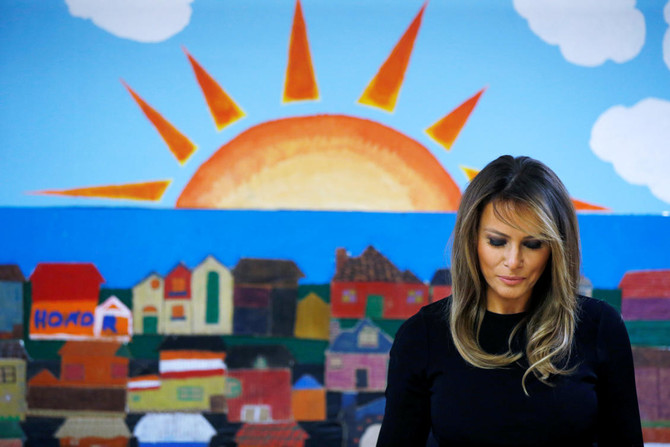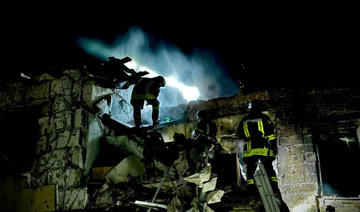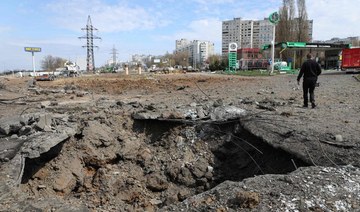WASHINGTON: Melania Trump lit up when a 3-year-old boy darted out of “Family Unit 8” at a migrant center in Tucson, Arizona.
“Hello!” said the first lady, brightening amid the semicircle of eight cells in a short-term holding center for migrants. “How are you?“
Mrs. Trump, an immigrant and a mother herself, wanted to find out more about how her husband’s strict immigration policy was playing out on the ground, especially among families that have been separated at the border. Two tours of migrant detention centers in a week gave her a sometimes grim view.
Now the question is what she does with that knowledge — and how she meshes it with her dislike for dividing up families and a concurrent belief in strong borders.
Spokeswoman Stephanie Grisham says more border visits or talks with lawmakers are possible, but it’s not clear what lessons the first lady took from her visits and what she’ll communicate to her husband.
“She cares about children deeply,” Grisham said. “She also believes in strong border laws and treating everybody equally.”
The first lady has given her husband her views on controversial political issues throughout his presidency, but never in such a public way as with the issue of immigrant children.
Before her husband reversed himself and put a halt to separations at the border, Mrs. Trump’s office put out a statement saying the first lady “hates” to see families separated and expressing hope that “both sides of the aisle” can reform the nation’s immigration laws. She did not say whether she supports the president’s “zero tolerance” policy for criminally prosecuting those who cross the border illegally.
“This is a complex issue,” Grisham said. “She recognizes that.”
The sights and sounds of Mrs. Trump’s visits to border facilities in Texas and Arizona amounted to a hard-to-forget information file about the 2,000 children separated from their families nationally.
Thursday’s visits to a migrant center and a school provided Mrs. Trump with indelible images and facts on the perils for families crossing the desert, the challenges for law enforcement and what happens to illegal border crossers and their children when they are caught.
Despite the camera-ready nature of the events, some of the images were bleak: a cell block, doors open at the time, where minors are sorted into “Families,” “Males” and “Processed” and “Unprocessed.” Six expressionless teenage boys seated on a bench outside their cell. A daycare for children under 2 and a few mothers — also minors.
At a Tucson roundtable with law enforcement officials responsible for hundreds of miles of border, the first lady asked how many children cross the desert alone. One official told her a 16-year-old was raped on her journey into the US and gave birth in federal custody.
Rodolpho Karisch, chief patrol agent for the Tucson Sector Border Patrol, showed Mrs. Trump a picture that appeared to take her aback. He said it represented a 6-year-old boy crossing the desert alone with a soda bottle and a note. Reporters later learned that the boy is alive.
The first lady at times deliberately leaves her message unclear.
On her first trip to the border, her choice of clothing left everyone scratching their heads, with the inscription on the back of her jacket that read, “I really don’t care, do u?“
On her second visit, her wardrobe was understated. But Mrs. Trump didn’t expound on her view of her husband’s immigration policy.
That didn’t stop critics of the Trump administration from lumping her in with her husband.
In Phoenix, as the first lady’s motorcade approached a sprawling Southwest Key migrant facility, protesters lined the sidewalk amid a big inflatable likeness of her husband, dressed in a white robe and holding a hood reminiscent of the Ku Klux Klan.
“Melania Trump is guilty, guilty, guilty!” the protesters chanted of the first lady, who is from Slovenia and came to the United States on a special visa during her modeling career.
Inside, she stopped at an air-conditioned trailer marked No. 4 that held 10 boys and girls around 5 years old.
“Do you like it here with some friends?” Mrs. Trump asked.
“Si,” said one girl.
A few protesters screamed from a nearby balcony that overlooked the compound’s playground as Mrs. Trump’s retinue shifted buildings.
Then came perhaps the most sobering stop, to another cooled room containing nine babies and toddlers, and four of their moms.
Mrs. Trump stepped onto the carpet in her sneakered feet and squatted down to get closer to the children, still sleepy from recent naps. She glanced up toward the women standing nearby and asked, “Who are the moms?” One woman from Honduras raised a hand. “Where is your baby?” the first lady asked. A translator helped the young woman point out a boy, 14 months old. An official traveling with Mrs. Trump said there were 121 children there and their average stay was 48 days.
The balcony was empty by the time Mrs. Trump departed.
At the gates of the compound, some protesters tried briefly to jog alongside the first lady’s motorcade as it sped, lights flashing, toward the airport and the four-hour flight back to Washington.
Melania Trump weighs migrant visits with husband’s policy
Melania Trump weighs migrant visits with husband’s policy

- Melania Trump wanted to find out more about how her husband’s strict immigration policy was playing out on the ground
- Now the question is what she does with that knowledge — and how she meshes it with her dislike for dividing up families
Harvard students end protest as university agrees to discuss Middle East conflict

- The student protest group Harvard Out of Occupied Palestine said in a statement that the encampment “outlasted its utility with respect to our demands”
- Students at many college campuses this spring set up similar encampments
CAMBRIDGE, Massachusetts: Protesters against the war between Israel and Hamas were voluntarily taking down their tents in Harvard Yard on Tuesday after university officials agreed to discuss their questions about the endowment, bringing a peaceful end to the kinds of demonstrations that were broken up by police on other campuses.
The student protest group Harvard Out of Occupied Palestine said in a statement that the encampment “outlasted its utility with respect to our demands.” Meanwhile, Harvard University interim President Alan Garber agreed to pursue a meeting between protesters and university officials regarding the students’ questions.
Students at many college campuses this spring set up similar encampments, calling for their schools to cut ties with Israel and businesses that support it.
The latest Israel-Hamas war began when Hamas and other militants stormed into southern Israel on Oct. 7, killing around 1,200 people and taking an additional 250 hostage. Palestinian militants still hold about 100 captives, and Israel’s military has killed more than 35,000 people in Gaza, according to Gaza’s Health Ministry, which doesn’t distinguish between civilians and combatants.
Harvard said its president and the dean of the Faculty of Arts and Sciences, Hopi Hoekstra, will meet with the protesters to discuss the conflict in the Middle East.
The protesters said they worked out an agreement to meet with university officials including the Harvard Management Company, which oversees the world’s largest academic endowment, valued at about $50 billion.
The protesters’ statement said the students will set an agenda including discussions on disclosure, divestment, and reinvestment, and the creation of a Center for Palestine Studies. The students also said that Harvard has offered to retract suspensions of more than 20 students and student workers and back down on disciplinary measures faced by 60 more.
“Since its establishment three weeks ago, the encampment has both broadened and deepened Palestine solidarity organizing on campus,” a spokesperson for the protesters said. “It has moved the needle on disclosure and divestment at Harvard.”
At least 15 injured in Russian strike on high-rise in Ukraine’s Kharkiv

- A fire broke out at another strike site, and at least ten garages were affected
KYIV: A Russian air attack on Kharkiv city center in Ukraine hit a high-rise residential building, injuring at least 15 people, including two children, local officials said on Tuesday.
It was not immediately clear what kind of weapon was used in the strike, but it landed on the 10th floor of the 12-story apartment block, officials said on Telegram.
Ihor Terekhov, the city’s major, said rescuers were searching for the injured.
One person was hospitalized in a serious condition, Oleh Syniehubov, the regional governor, added.
A fire broke out at another strike site, and at least ten garages were affected, Syniehubov said.
Kharkiv, Ukraine’s second largest city, and the surrounding region have long been targeted by Russian attacks but the strikes have become more intense in recent months, hitting civilian and energy infrastructure.
Two French prison officers killed in inmate's escape

- The incident took place late morning at a road toll in Incarville in the Eure region of northern France
- The inmate was being transported between the towns of Rouen and Evreux in Normandy
ROUEN, France: Gunmen on Tuesday attacked a prison van at a motorway toll in northern France, killing at least two prison officers and freeing a convict who had been jailed last week.
President Emmanuel Macron vowed that everything would be done to find those behind the attack as hundreds of members of the security forces were deployed for a manhunt to find the attackers and the inmate who were all still at large.
Two prison officers were killed in the attack and two others are receiving urgent medical care, Paris prosecutor Laure Beccuau said in a statement.
The incident took place late morning at a road toll in Incarville in the Eure region of northern France, a source close to the case added.
The inmate was being transported between the towns of Rouen and Evreux in Normandy.
A police source said several individuals, who arrived in two vehicles, rammed the police van and then fled.
One of them was wounded, the police source said.
It was not immediately clear how many attackers there were in total.
"Everything is being done to find the perpetrators of this crime," Macron wrote on X.
"We will be uncompromising," he added, describing the attack as a "shock".
Justice Minister Eric Dupond-Moretti immediately headed to a crisis cell at his ministry.
"These are people for whom life counts for nothing. They will be arrested, they will be judged and they will be punished according to the crime they committed," he said.
Both the officers killed were men and they were the first prison officers to be killed in the line of duty since 1992, he added.
One of them was married and had two children while the other "left a wife five months pregnant", he said.
"I am frozen with horror at the veritable carnage that took place at the Incarville toll," said Alexandre Rassaert, the head of the Eure region council.
"I hope with all my heart that that the team of killers which carried out this bloody attack will be arrested quickly."
A unit of the GIGN elite police force has been despatched to apprehend the suspects.
Traffic was stopped on the A154 motorway where the incident took place.
Interior Minister Gerald Darmanin wrote on X he had ordered the activation of France's Epervier plan, a special operation launched by the gendarmerie in such situations.
"All means are being used to find these criminals. On my instructions, several hundred police officers and gendarmes were mobilised," he said.
Prosecutor Beccuau named the inmate as Mohamed Amra, born in 1994, saying that last week he had been convicted of aggravated robbery and also charged in a case of abduction leading to death.
The case has been handed to prosecutors from France's office for the fight against organised crime known by their acronym JUNALCO.
Law and order is a major issue in French politics ahead of next month's European elections and the incident sparked fierce reactions from politicians, especially the far right.
"It is real savagery that hits France every day," said Jordan Bardella, the top candidate for the far-right National Rally (RN) which is leading opinion polls for the elections.
Indonesia’s president-elect seeks to boost defense ties with UAE

- Prabowo Subianto is set to succeed President Joko Widodo in October
- His visit to Abu Dhabi seen as a strategic move ahead of presidency
JAKARTA: Indonesia’s President-Elect Prabowo Subianto wants to boost defense ties with the UAE, his office said on Tuesday, as he made the first official trip to Abu Dhabi since winning the general vote.
Indonesia-UAE relations grew under incumbent Indonesian President Joko Widodo, who in 2021 secured an over $46 billion investment commitment from the Gulf state. A year later, the two countries signed a free trade deal, which came into force last September.
Subianto, a former special forces commander and Indonesia’s current defense minister, is set to succeed Widodo and take office in October following his landslide victory in the presidential election in February.
On Monday, he was in Abu Dhabi to receive the UAE’s highest civilian honor, the Order of Zayed, in recognition of his efforts in enhancing bilateral ties.
“I hope Indonesia-UAE relations will continue to develop and grow in accordance with the ambitions of the two countries in strengthening cooperation across various fields, including in defense,” Subianto said in a statement after meeting UAE President Sheikh Mohammed bin Zayed Al-Nahyan.
During Subianto’s time in office as minister, Indonesia and the UAE agreed to strengthen defense ties with the signing of a memorandum of understanding in 2020, followed by a protocol agreement on the development of their defense industries in 2022.
Subianto’s visit to the UAE can be seen as a strategic move ahead of his presidency.
“As we get closer to his inauguration, Prabowo has gained a boost in confidence to directly meet with MBZ and discuss strategic issues at the bilateral, regional and global level,” said Teuku Rezasyah, an international relations expert from Padjadjaran University in West Java.
“It’s only natural that Prabowo is visiting Abu Dhabi because it’s one of the world’s biggest sources of foreign investments … Certainly, Prabowo wants to seriously guarantee that investments from Abu Dhabi will be very strategic in the development of Indonesia.”
India sets sights on Iranian port as gateway to Afghanistan, Central Asia

- New Delhi signed a 10-year deal to operate Chabahar port on Monday
- India began helping Iran to develop Chabahar in 2016
NEW DELHI: India’s newly signed deal to operate the Iranian port of Chabahar is expected to provide it a gateway to landlocked Afghanistan and Central Asia, offering possible competition to Pakistan’s Gwadar.
The 10-year contract, under which India will invest $120 million in Chabahar’s infrastructure, was signed in Tehran on Monday between the state-owned Indian Ports Global Ltd and the Port & Maritime Organization of Iran.
India’s Shipping Minister Sarbananda Sonowal welcomed the deal, saying the development of Chabahar was an “India-Iran flagship project” and that the port would be a “gateway for trade with Afghanistan and broader Central Asian countries.”
New Delhi’s commitment to Chabahar started in May 2016 when Iran, India, and Afghanistan signed a trilateral transit agreement to develop the port into a regional trade hub.
“The signing of the deal signifies the strength of bilateral ties between India and Iran,” said D.P. Srivastava, who was India’s ambassador to Iran when talks on the project started.
“The present agreement will build on progress achieved so far.”
India’s 2016 involvement in Chabahar came after the US eased sanctions on Iran. The sanctions were reimposed by Donald Trump’s administration in 2018.
After the signing of Monday’s agreement, US State Department spokesperson Vedant Patel told reporters that the sanctions on Iran remained in place, and that Washington would enforce them.
Prof. Sujata Ashwarya from the Centre for West Asian Studies at Jamia Millia Islamia in New Delhi said it was not likely that sanctions would affect India, as its presence was helping deter China — the main rival of the US — from becoming involved in the Iranian port.
“(India) will effectively keep China out of the project,” Ashwarya said. “If we are there, then China won’t be there, and the US would not impose sanctions.”
Located in Iran’s southeast, Chabahar is less than 100 km from Gwadar in southwestern Pakistan — a flagship project of the multibillion-dollar China–Pakistan Economic Corridor under Beijing’s Belt and Road Initiative.
Ashwarya said the Iranian port is Gwadar’s potential competitor.
“It is an investment in trade facilitation with an eye on making Chabahar a hub,” she said.
“It provides competition to Gwadar, it could potentially lead to a secured corridor to Afghanistan and Central Asia, which means that India’s trade with these regions can flourish and broaden.”


















